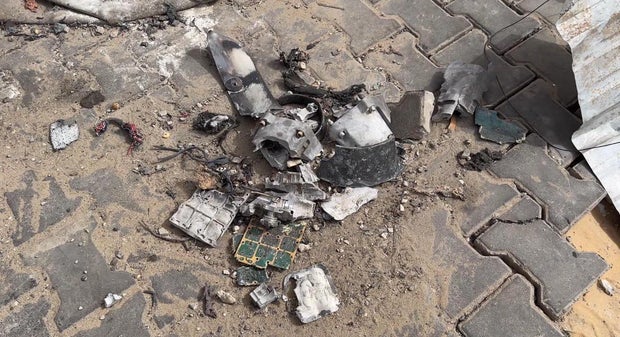[ad_1]
Analysis of images of shrapnel gathered at the scene of an Israeli strike in Rafah on Sunday showed evidence of a bomb that was a U.S.-made GBU-39, two munitions experts told CBS News. Dozens of Palestinians were killed in the strike and subsequent fires.
“I instantly knew the housing was a GBU,” Trevor Ball, who worked as an ordnance disposal tech – or bomb diffuser – for the U.S. Army for five years, told CBS News. “I’ve seen a lot of them in this conflict, and I’ve even gone back and looked at past conflicts just to get an idea of what ordinance Israel has used in the past when I started looking into this, and it’s a very distinct object, the GBU. It’s a very unique round.”
Photos and videos used to identify the bomb remnants were taken by journalist Alam Sadeq in Gaza, who visited the scene of the strike early on Monday.
Alam Sadeq
He told CBS News he was searching the area, including around damaged tents that had once housed civilians, when he identified several pieces of shrapnel with English words on them.
He said he recognized the words from bomb remnants he had seen after a previous strike on a building in Gaza, so he gathered the fragments together in a pile and photographed them.
“The whole actuator assembly is unique,” Ball told CBS News, explaining his identification process using the images of the shrapnel from the scene. “It’s just not in other rounds.”
Alam Sadeq
Richard Weir, senior researcher in the Crisis, Conflict and Arms division at Human Rights Watch, agreed with Ball.
“One of the critical elements here, right, is… the tail section. Sometimes it’s referred to as the control section or the actuator section, which moves the fins in the rear. That matches up directly with the GBU-39 small diameter bomb, which is U.S. made,” Weir said. “It also matches with the idea of the description of the size of the warhead, in terms of the explosive weight.”
Israeli military spokesperson Daniel Hagari said in a briefing on Tuesday that the Israeli strike on Rafah “was based on precise intelligence that indicated that these terrorists who were responsible for orchestrating and executing terror attacks against Israelis were meeting inside the specific structure we targeted.”
Hagari said that “the strike was conducted using two munitions with small warheads, suited for this targeted strike. We’re talking about munitions with 17 kilos of explosive material. This is the smallest munition that our jets can use. Following the strike a large fire ignited for reasons that are still being investigated. Our munition alone could not have ignited a fire of this size.”
After the deadly strike, Israeli Prime Minister Benjamin Netanyahu said there had been a “tragic mishap” and that Israel was investigating. He did not elaborate.
Weir said the bomb was “a very small weapon as far as air dropped munitions,” but that it still carries “severe risk,” especially when used near populated areas. He told CBS News that it wasn’t the smallest weapon that could have been used to carry out a precision strike.
“Israel has plenty of other munitions, in fact, that it has used in the past, in the fighting in Gaza and elsewhere,” Weir said. “So it has other options available. It’s just simply not the case that this was the only weapon that they could use to strike a target in, or near, a densely populated, internally displaced persons camp.”
“I don’t know enough about the aircraft integration, but it’s not the smallest munition they have for precision strikes,” Ball, the former bomb diffuser, said. “They commonly use drone-employed weapons that have a much smaller effective area.”
Both Weir and Ball also said that a bomb of any size could potentially start a fire.
“Explosives release a lot of heat when they explode, and they can often cause fires,” Ball said. “Technically, if you drop one in the desert and there’s no fuel around, yeah, it can’t cause a fire on its own, because there’s no fuel to burn. But you’re dropping it in an area where there’s a lot of other flammable materials, from people living and being in camps… it could easily have caused a fire.”
Emmet Lyons in London and Marwan al-Ghoul in Gaza contributed to this report.





